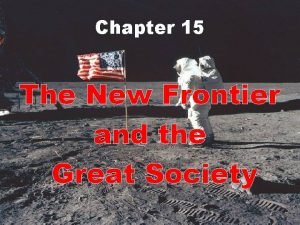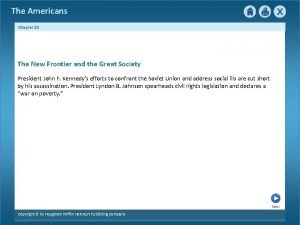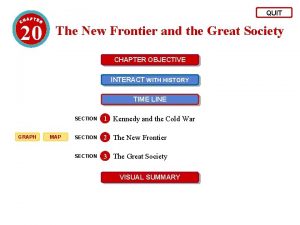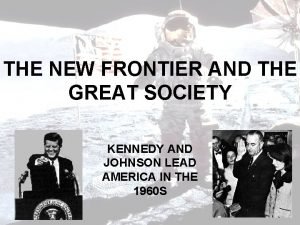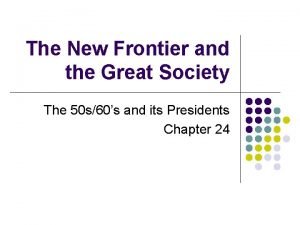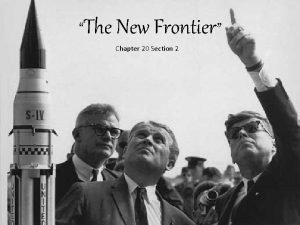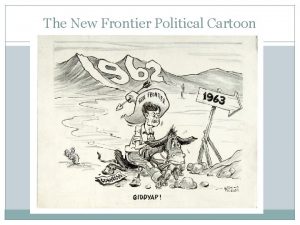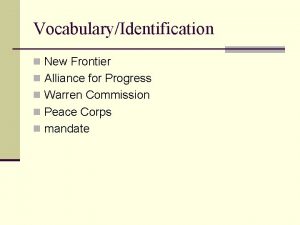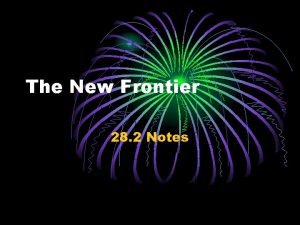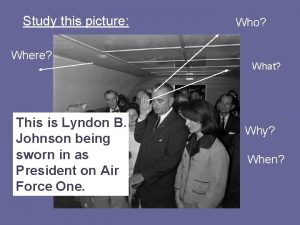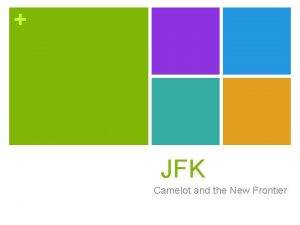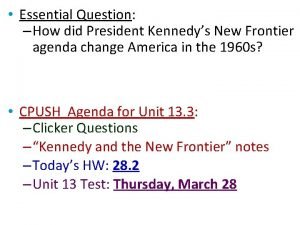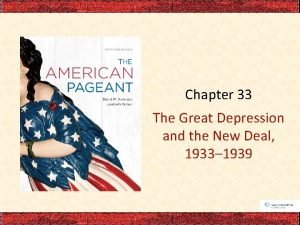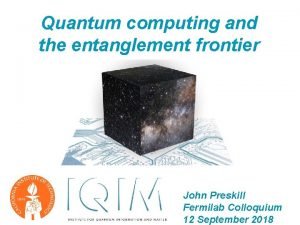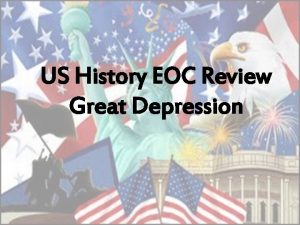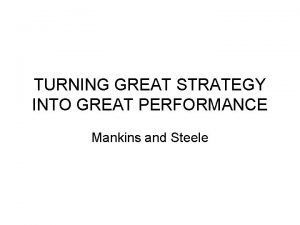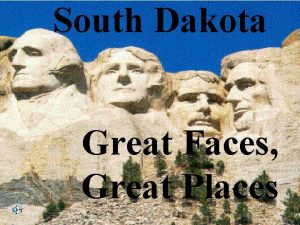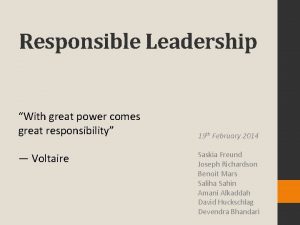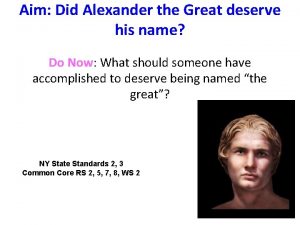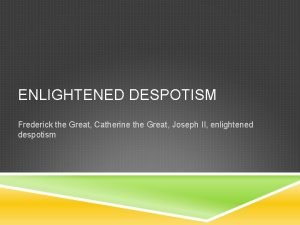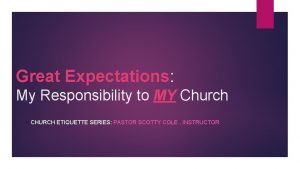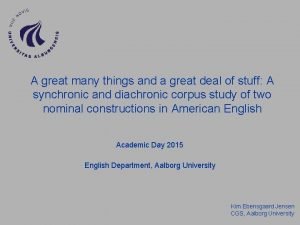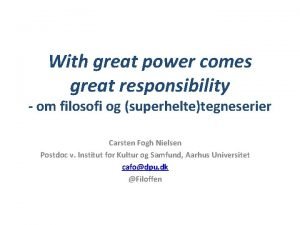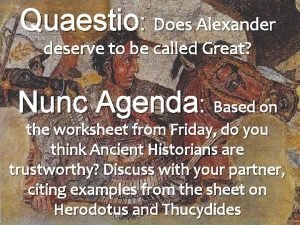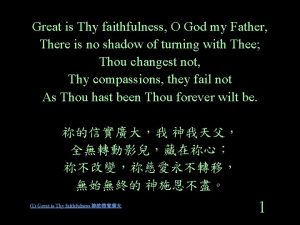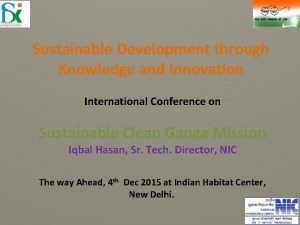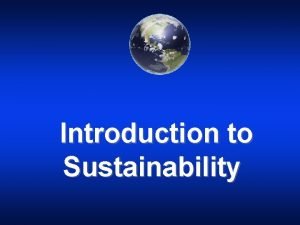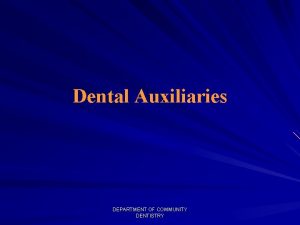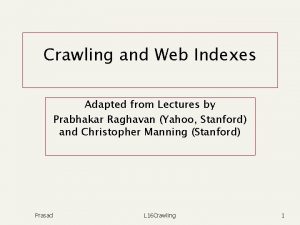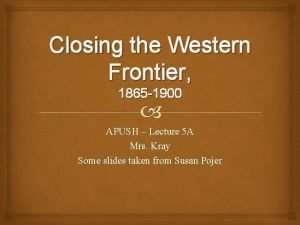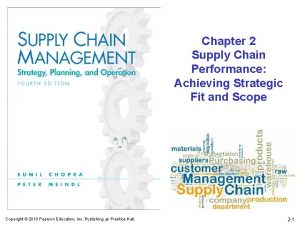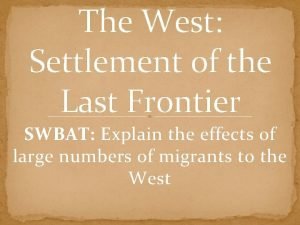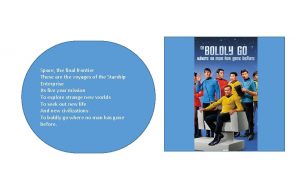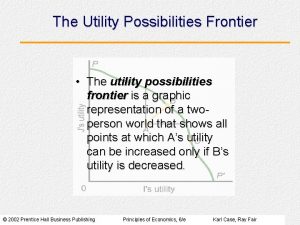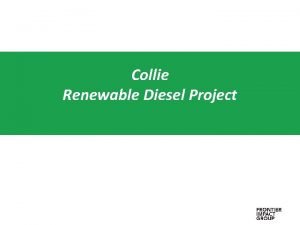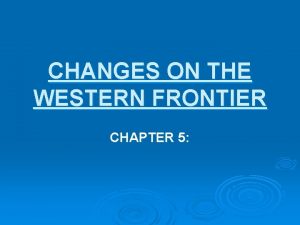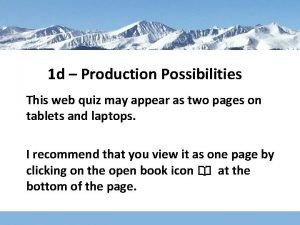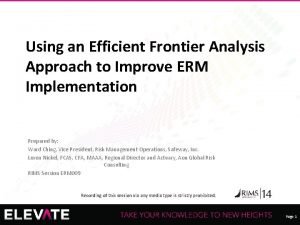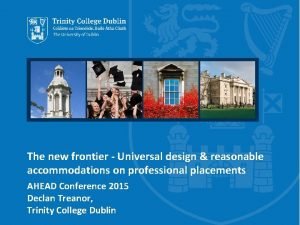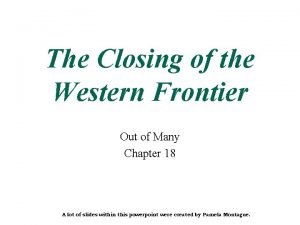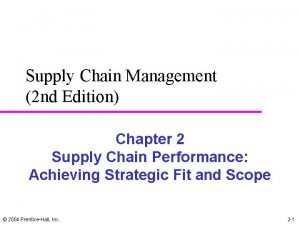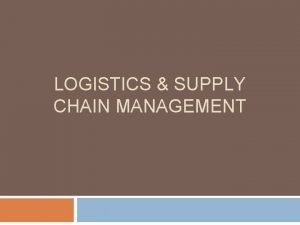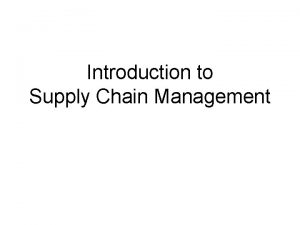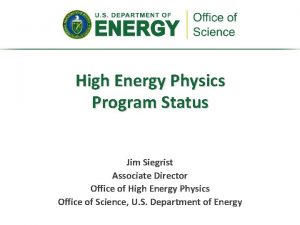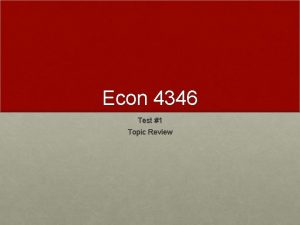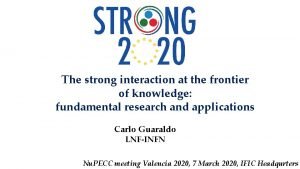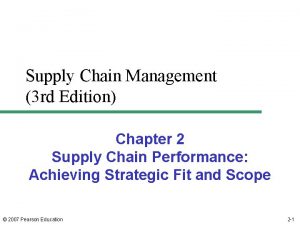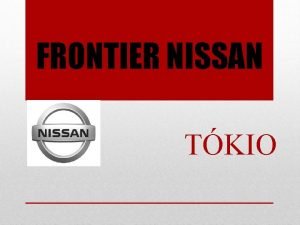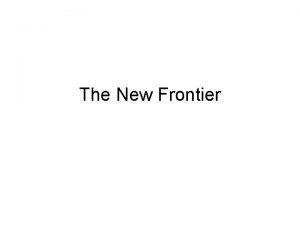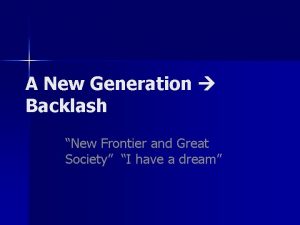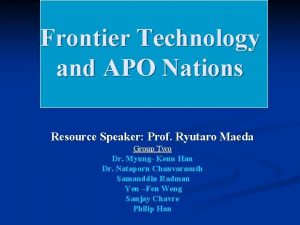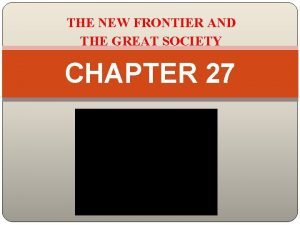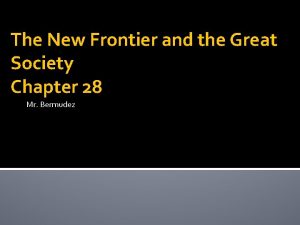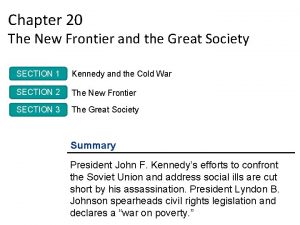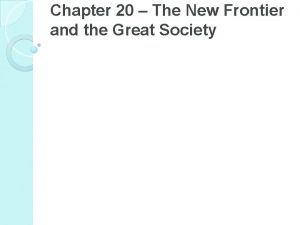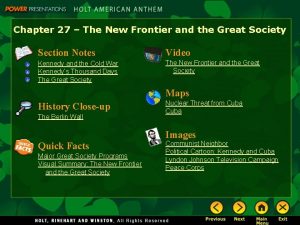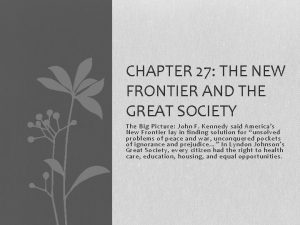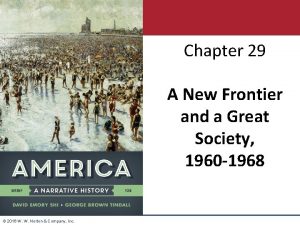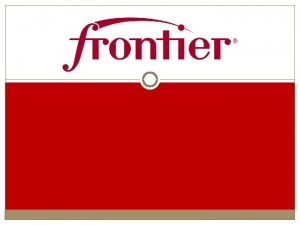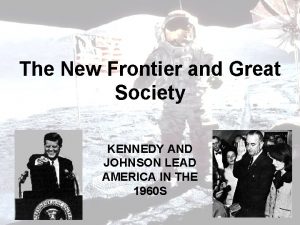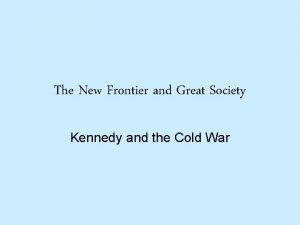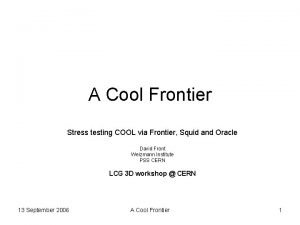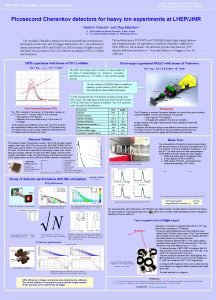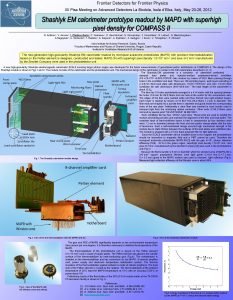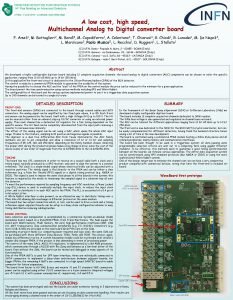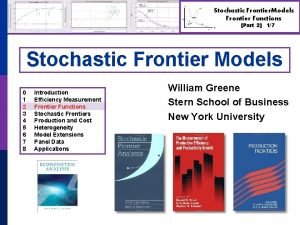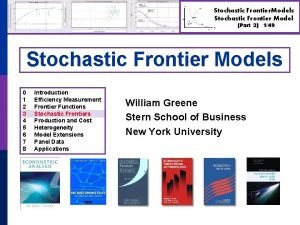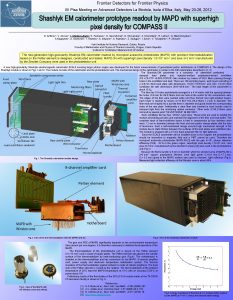Chapter 15 The New Frontier and the Great

































































- Slides: 65

Chapter 15 The New Frontier and the Great Society

I. The New Frontier A. The Election of 1960 1. Candidates a. John F. Kennedy (D) * VP = LB Johnson (TX) 1) Catholic – this was an issue 2) Wealthy, privileged, Northeast background 3) Young (43)

b. Richard Nixon (R) * VP = Henry Cabot Lodge Jr. 1) Quaker 2) financially struggling background 3) California 2. A New Kind of Campaign a. TV made the difference – 1 st televised in an American election 1) Kennedy poised, confident, young- master of the media 2) Nixon tired, stiff, ill at ease Nixon-Kennedy Debate b. Began new era – image matters – TV a new voting tool

3. JFK wins in the closest election of the century

1960 Election Results

B. The Kennedy Mystique – youth, optimism 1. Inauguration Day: Jan 20, 1961 Ask not… - Called on citizens to take more active role in making US a better place – “ask not” speech 2. Surrounded himself w/ youth & intelligence: “the best & the brightest” (S of State Rusk; S of Def Mc. Namara; Att. Gen RF Kennedy) 3. Camelot image – beautiful wife, beautiful kids, style, culture, charisma

Camelot

C. Domestic Agenda = The New Frontier 1. Legislative Goals a. increase aid to education b. health insurance for elderly c. Create Dept. of Urban Affairs d. Urban renewal programs e. Help migrant workers f. Min. wage increase g. expand Social Security 2. Congress’ reaction? Republicans + Southern Democrats a. Negative b. Viewed New Frontier as too big, too costly

3. JFK’s economic agenda a. The Economic scenario in the early 1960 s: Economy Slow: GNP down, unemployment up. b. JFK’s plan: 1) spend more! (Keynesian approach) – deficit spending 2) tax cuts to stimulate consumer spending – biz could expand, create new jobs, everybody benefits (supply side economics)

4. JFK addresses Women’s Rights a. Presidential Commission on Status of Women - called for an end to gender discrimination in civil svc b. Equal Pay Act - JFK issued this executive order that called for equalized pay for men & women

5. JFK addresses the Disabled a. President’s Panel on Mental Retardation Commission - called for funding and research into developmental disabilities and educational and vocational programs for people with disabilities b. Mental Health Centers Construction Act of 1963 - provided funds to build research centers and mental health centers c. Special Olympics - began in 1962 by Eunice Kennedy Shriver (JFK’s sister) - allows people with disabilities a chance to be competitive

D. The Warren Court – the most liberal in US History 1. Chief Justice Earl Warren a. led what was considered an Activist Court: judicial activism: occurs when judges seek to enact legislation through court rulings – through rulings, seem to make laws rather than interpret them b. Warren Court also applied what is known as judicial interpretation to the Constitution. This brought up the debate between strict construction and judicial interpretation (also known as loose construction) Strict Construction: allows only a literal reading and strict interpretation of the Constitution – restricts judicial interpretation Judicial Interpretation: occurs when justices extend the Constitution’s meaning beyond the framers’ original intent and allows for reasonable inferences based on the text - loose interpretation

2. Warren Court Issues and Reforms a. “One Man, One Vote” and Reapportionment reapportionment: the method states use to draw up political districts based on changes in population 1) background: In 1960, 80% of Americans lived in the cities/burbs. States were over-representing rural areas. The result? The vote of a city dweller counted for less than the vote of a rural resident. 2) The solution? a) Baker v. Carr (1962) - made such arrangements illegal. Upheld principal of “one man, one vote”

Texas Political Districts (2010 census)

b) Reynolds v. Sims (1964) - State legislative districts should be = in population. - shifted political power from rural, often conservative areas to urban areas where more liberal voters resided

b. Extending Due Process - strengthen rights of people accused of crimes Due Process: a judicial requirement that laws may not treat individuals unfairly, arbitrarily, or unreasonably, and that courts must follow proper procedures and rules when trying cases

1) Gideon v. Wainwright (1963) - State courts must provide a lawyer in criminal cases where defendant couldn’t afford one 2) Escobedo v. Illinois (1964) - accused person has right to have lawyer present when being questioned by police 3) Miranda v. Arizona (1966) - police must inform suspects of their legal rights at time of arrest

c. Prayer & Privacy 1) Engel v. Vitale (1962) - states can’t compose official prayer and require them to be recited in public school 2) Griswold v. Connecticut (1965) - to prohibit the sale & use of birth control violated the constitutional right to privacy

3. Effects of Litigation on the democratic process litigation: the process of taking legal action a. Many Warren court reforms were initiated by citizens who exercised their right to participate in the democratic process in the US – they sued through the legal system and the cases went all the way up to the Supreme Court b. other methods of participating in the democratic process 1) lobbying (working to influence gov’t decisions that relate to a particular industry, issue, etc) 2) non-violent protesting 3) amendments to the US Constitution


II. JFK & the Cold War A. JFK’s Foreign Policy: Flexible Response 1. The plan… a. Address the growing threat of the USSR 1) biggest threat to freedom? “iron tyranny” of communism 2) to fight communism, Americans must be willing to “pay any price” and “bear any burden” b. JFK increased defense spending – options (Ike cut spending on non-nuke forces – Massive retaliation to deter USSR. But USSR has nukes too – US faced nuclear devastation)

Why increase Conventional forces? To avoid mutually assured destruction (mad)

c. Flexible Response - policy of seeking a range of options from which to choose in dealing w/ int’l crisis 1) increased nuclear stockpile 2) expanded non-nuke forces-conventional troops/weapons 3) built up elite branch of army called the Special Forces (Green Berets) to wage guerilla warfare in limited conflicts

2. JFK offers financial aid to other countries a. Problems in Latin America 1) gov’ts in hands of wealthy few/ masses in extreme poverty 2) growing movements to overthrow LA gov’ts 3) some resented American “imperialism” b. JFK feared the spread of communism in Latin America. Knowing that communism fed on poverty & social injustice, he urged Americans to support aid programs to the region

c. Alliance for Progress: 1) a “Marshall Plan” for Latin America aimed at containing communism in Latin America by offering economic & technical aid to Latin American nations ($ for schools, housing etc) 2) mostly a failure as $ ended up in the hands of wealthy & strengthened rule of dictators Example: Anastasio Somoza: His family almost continually ruled Nicaragua from 1936 to 1980.

d. The Peace Corp 1) A volunteer program to provide help to developing nations 2) Fights poverty by performing humanitarian service – containing communism at the same time!

4. The Space Race a. Space race: Cold War competition over dominance of space exploration capability b. If USSR 1 st in space technology, might appear communism better than capitalism 1) JFK wants man on moon 2) NASA begins effort to produce necessary technology c. John Glenn 1962 – 1 st American to orbit the earth

d. Apollo Program 1) developed Saturn V - largest, most powerful rocket ever built - enough velocity to escape earth’s gravity and to reach the moon! 2) July 20, 1969 - 1 st Man on the Moon: Neil Armstrong An American!! - "That's one small step for a man, one giant leap for mankind“ - event televised. Seen by millions Race to the Moon

e. 1969 Moon landing = Turning Point in US History 1) US had won the space race - USSR never again rivaled the US for supremacy in space 2) Space program’s many innovations improved Americans’ quality of life - improved transmission tech via satellites to transmit radio, phone& TV - advances in battery and solar cell tech - cordless tools - food tech such as freeze-drying & enriched baby food - memory foam for beds and chairs - flame resistant fabrics - robotics - new types of rubber used in athletic shoes


B. Crises of the Cold War 1. Bay of Pigs Invasion a. background 1) 1959: Cubans overthrow dictatorship of Fulgencio Batista 2) uprising led by Fidel Castro (who at 1 st, didn’t seem so bad – visited DC, claimed he wasn’t communist) I swea r I’m not a comm un heehe ist ehee

b. Cuban Communism 1) Castro establishes ties w/ USSR 2) jailed/murdered opponents 3) seized foreign owned (many US) property/biz 4) drastic land reforms – socialism 5) USSR indicates plan to strengthen Cuba’s military


c. US Response? Communism too close! 90 miles from Key West FL to Havana, Cuba 1) Ike breaks diplomatic ties 2) CIA develops plan to eliminate Castro d. The Plan – begun under Ike, approved by JFK 1) train anti-Castro Cuban exiles La Brigada 2) force would land on Cuba & inspire Cuban people to rise up against Castro

e. The Invasion. April 17, 1961. Total disaster! 1) Cuban exile force ashore at Bahia de Cochinos “Bay of Pigs” 2) CIA maps/intelligence outdated. Ignored coral reef info 3) La Brigada boats old & leaky, run aground on coral reefs 4) JFK cancelled air support to keep US involvement secret 5) popular uprising never materializes

f. The result? 1) w/in 72 hrs, most invaders killed or captured 2) US pays ransom to get back captured invaders 3) American prestige/goodwill shaken worldwide 4) JFK’s admin. appears weak/disorganized Cartoonists ridiculed Kennedy for the Bay of Pigs fiasco. In this drawing from the Washington Star, the Bay of Pigs is portrayed as a giant chicken which has come home to roost, causing new troubles soon to hatch out for Kennedy.

2. Berlin Wall Goes UP a. JFK/Krushchev meet in Vienna, June 1961 1) subject of debate: City of West Berlin 2) West Berlin = non-communist outpost in the heart of communist East Germany (a symbol of freedom to Western nations) 3) also a gateway for E. Germans to escape to the West (freedom!)

Why they built The Berlin Wall

b. Khrushchev demands western withdrawal from Berlin 1) JFK refuses – reaffirms US commitment to W. Berlin 2) JFK believes crisis over Berlin could lead to war – calls for more defense spending c. Rather than attack W. Berlin, Communists build a wall, sealing off Western sector Berlin Wall

1) wall allows USSR to avoid a showdown over W. Berlin 2) Becomes a symbol of the Cold War division of East/West 3) 1963: JFK gives “ich bin ein Berliner” speech “All free men, wherever they may live, are citizens of Berlin. And, therefore, as a free man, I take pride in the words ‘Ich bin ein Berliner’ (I am a Berliner). ”

3. Cuban Missile Crisis (13 Days - Oct, 1962) a. background 1) US receives spy-plane info that USSR installing missiles in Cuba 2) prospect of nuclear warheads 90 mi from US a threat!

b. US Response 1) Oct 22, 1962 JFK gives TV speech about Soviet missiles in Cuba 2) JFK orders a naval blockade to stop USSR from delivering more missiles 3) JFK demands USSR dismantle existing missile sites

an Missile Cri

c. Soviets offer a deal 1) USSR would remove missiles if US promised not to invade Cuba & US would remove missiles from Turkish/Soviet border 2) JFK publicly agrees not to invade Cuba, privately agrees to remove missiles from Turkey, USSR agreed to remove missiles from Cuba

4. Impact of Cuban Missile Crisis a. World closer to nuclear destruction than ever before or since b. US & USSR forced to consider consequences of nuclear war c. Signed the Nuclear Test Ban Treaty (Aug 1963) – agreement btwn US, UK, USSR to stop all nuclear weapons’ tests in the air and under water – the 1 st step toward mutual arms reduction since beginning of Cold War d. Khrushchev falls from power Oct 1964 e. Evident that USSR militarily inferior – led to dramatic arms build-up in USSR followed by US arms build-up in early ’ 80 s

C. Death of a President 1. Nov. 22, 1963 a. In Dallas for series of political appearances b. JFK shot and killed during motorcade

JFK Funeral On November 23 to 24, 1963, J. F. Kennedy lay in state in the Rotunda of the U. S. Capitol. More than 250, 000 people waited up to ten hours in lines that often stretched 40 blocks paid their respects to the slain president. The shocked nation was in deep, collective mourning.

An estimated one million people lined the streets to mourn and view the formal funeral procession on November 25, 1963 for President John F. Kennedy, from the U. S. Capitol to St. Matthew's Cathedral, then to his final resting place at Arlington National Cemetery.


2. Killer? Lee Harvey Oswald (had ties to USSR) 3. LH Oswald killed by Jack Ruby (nightclub owner)

4. LBJ becomes US President 5. Warren Commission 1964 a. commission formed to investigate assassination of JFK b. conclusion? Oswald = lone shooter

III. The Great Society A. Johnson becomes President 1. background a. Texan who was not poor, but grew up among poor people b. ran for Congress 1937 – won at age 29 c. elected to Senate 1948

2. Johnson’s Experience in Gov’t (26 yrs in Congress!!) a. Congressional staffer b. House of Rep c. US Senator d. Senate majority leader e. VP Lyndon B. Johnson campaigns for the U. S. Senate in 1941. (Lyndon B. Johnson Presidential Library. ) Johnson as VP 1961

3. Johnson’s leadership style “Johnson Treatment” a. Did favors, twisted arms, bargained, flattered, threatened, appealed to patriotism, appealed to pwr b. mastered the art of behind the scenes maneuvering & political compromise c. spoke directly, convincingly & rough – a big contrast from JFK’s elegant society image d. using all techniques, LBJ sought to find consensus – general agreement e. ability to build coalitions f. ambitious – wanted to achieve great things, be remembered as a great president

4. Kennedy’s Legacy a. used nat’l grief to build support for legislation b. Congress had already rejected most of JFK’s proposals, but LBJ called for immediate action on them - to refuse them would be to reject ideals of a nat’l hero - “nothing could more eloquently honor Pres. Kennedy’s memory than the earliest passage of the civil rights bill for which he fought” - “let us here highly resolve that J. F. Kennedy did not live – or die – in vain”

c. before end of 1964, won a tax cut & a major civil rights bill d. Civil Rights Act of 1964: prohibited an employer from denying someone a job b/c of race, sex or religion – gave gov’t power to desegregate public places

5. Views on Poverty a. felt that a wealthy, powerful gov’t could & should try to improve lives of its citizens b. declared unconditional war on poverty c. Economic Opportunity Act: established range of programs aimed at creating jobs & fighting poverty d. Office of Economic Opportunity: (OEO) – new programs directed at young Americans living in the inner city e. VISTA (volunteers in svc to America) – a domestic peace corp – put young people w/ skills & community-minded ideals to work in poor neighborhoods & rural areas to help people overcome poverty

6. Election of 1964 a. LBJ (D) vs. Barry Goldwater (R) b. issue: Vietnam - Goldwater wanted full US military intervention in Vietnam - Johnson pledged not to use combat soldiers - LBJ wins

Political Party Presidential Nom. VP Nom. Democratic Lyndon B. Johnson Hubert H. Humphrey Republican Barry Goldwater William E. Miller Electoral Popular # % 486 90. 3 52 9. 7 # 43, 129, 5 66 27, 178, 1 88 % 61. 1 38. 5

B. The Great Society 1. Johnson’s vision for a more perfect, equitable society 2. Goals? a. Abundance & liberty for all b. end to poverty c. End to racial injustice 3. Significant Great Society legislation a. Medicare: health insurance for elderly funded thru Social Security b. Medicaid: gov’t financed health care for those on welfare or living below the poverty line

c. Head Start: preschool program for disadvantaged children d. VISTA: put young people to work in poor school districts

e. Inner City programs - combated deteriorating inner cities - created Dept of Housing and Urban Development 1965. Robert Weaver = 1 st black American in a Cabinet post f. Immigration Reform Act 1965: - strict limit on # of immigrants allowed into US per year - eliminated the national origins system, which gave preference to northern European immigrants - thus, increased immigration from Asia, Africa and Latin America



C. Legacy of the Great Society 1. Increased size and scope of American Gov’t - as did the Progressive Era/New Deal 2. Praised for improving lives of many a. $ and benefits to poorer communities b. political & administrative experience to minority groups 3. Criticized for the massive growth of federal programs and intruding too much into American lives a. programs too expensive b. Constitutional debate about how far the gov’t should extend itself in helping the less fortunate; how should “promote the general welfare” be interpreted?
 Chapter 15 the new frontier and the great society lesson 1
Chapter 15 the new frontier and the great society lesson 1 The americans chapter 28
The americans chapter 28 The new frontier and great society
The new frontier and great society Frontier detectors for frontier physics
Frontier detectors for frontier physics New frontier vs great society
New frontier vs great society New frontier vs great society
New frontier vs great society Chapter 20 section 2 the new frontier
Chapter 20 section 2 the new frontier New frontier jfk definition
New frontier jfk definition Frontiern
Frontiern New frontier camelot
New frontier camelot New frontier jfk
New frontier jfk New frontier camelot
New frontier camelot Kennedys new frontier
Kennedys new frontier Chapter 33 the great depression and the new deal
Chapter 33 the great depression and the new deal Chapter 16 toward a new heaven and a new earth
Chapter 16 toward a new heaven and a new earth Quantum computing
Quantum computing Aaa new deal logo
Aaa new deal logo Main idea
Main idea New york, new jersey, pennsylvania, and delaware
New york, new jersey, pennsylvania, and delaware New oil and new wineskin
New oil and new wineskin 3 weaknesses of the articles of confederation
3 weaknesses of the articles of confederation New marketing realities pdf
New marketing realities pdf New classical macroeconomics
New classical macroeconomics Neil thisse is a loyalist who fled the colonies
Neil thisse is a loyalist who fled the colonies New classical and new keynesian macroeconomics
New classical and new keynesian macroeconomics Turning great strategy into great performance
Turning great strategy into great performance Great faces
Great faces With leadership comes great responsibility
With leadership comes great responsibility Hammerhead shark vs great white
Hammerhead shark vs great white Did alexander the great deserve to be called great
Did alexander the great deserve to be called great Frederick the great enlightened despot
Frederick the great enlightened despot With great expectations comes great responsibility
With great expectations comes great responsibility A great deal vs a great many
A great deal vs a great many With great power comes great responsibility batman
With great power comes great responsibility batman Does alexander deserve to be called the great
Does alexander deserve to be called the great No shadow of turning
No shadow of turning Obsolescent “frontier” civilization
Obsolescent “frontier” civilization Obsolescent frontier'' civilization definition
Obsolescent frontier'' civilization definition Production possibility curve
Production possibility curve Auxiliary dental definition
Auxiliary dental definition Mercator url frontier
Mercator url frontier Range wars apush
Range wars apush Zone of strategic fit
Zone of strategic fit Cedar point forbidden frontier
Cedar point forbidden frontier The west settlement of the last frontier
The west settlement of the last frontier Space the final frontier these are the voyages
Space the final frontier these are the voyages Frontier trail middle school
Frontier trail middle school Utility possibilities frontier
Utility possibilities frontier Obsolescent frontier civilization diagram
Obsolescent frontier civilization diagram Grapheneq
Grapheneq Changes on the western frontier
Changes on the western frontier Artificial intelligence the next digital frontier?
Artificial intelligence the next digital frontier? Draw ppc
Draw ppc Efficient frontier case study
Efficient frontier case study Frontier placements
Frontier placements Closing of the western frontier
Closing of the western frontier The bitter conflict between whites and indians intensified
The bitter conflict between whites and indians intensified Interfunctional scope
Interfunctional scope Cost responsiveness efficient frontier
Cost responsiveness efficient frontier Cost-responsiveness efficient frontier
Cost-responsiveness efficient frontier Jim siegrist
Jim siegrist Roduction possibilities frontier
Roduction possibilities frontier Frontier meaning
Frontier meaning Conventional/stylized design
Conventional/stylized design Frontier of knowledge
Frontier of knowledge Implied demand uncertainty in supply chain management
Implied demand uncertainty in supply chain management
